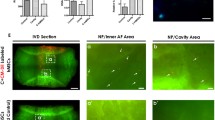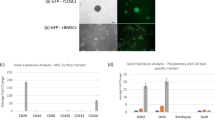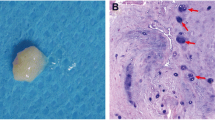Abstract
Intervertebral disc (IVD) degeneration is an asymptomatic pathophysiological condition and a strong causative factor of low back pain. There is no cure available except spinal fusion and pain management. Stem cell-based regenerative medicine is being considered as an alternative approach to treat disc diseases. The current study aimed to differentiate human umbilical cord-mesenchymal stem cells (hUC-MSCs) into chondrocyte-like cells and to elucidate their feasibility and efficacy in the degenerated IVD rat model. Chondrogenic induction medium was used to differentiate hUC-MSCs into chondroprogenitors. Rat tail IVD model was established with three consecutive coccygeal discs. qPCR was performed to quantify the molecular markers of pain and inflammation. Histological staining was performed to evaluate the degree of regeneration. Induced chondroprogenitors showed the expression of chondrogenic genes, SOX9, TGF-β1, ACAN, BMP2, and GDF5. Immunocytochemical staining showed positive expression of chondrogenic proteins SOX9, TGF-β1, TGF-β2, and Collagen 2. In in vivo study, transplanted chondroprogenitors showed better survival, homing, and distribution in IVD as compared to normal MSCs. Expression of pain and inflammatory genes at day 5 of cell transplantation modulated immune response significantly. The transplanted labeled MSCs and induced chondroprogenitors differentiated into functional nucleus pulposus (NP) cells as evident from co-localization of red (DiI) and green fluorescence for SOX9, TGF-β1, and TGF-β2. Alcian blue and H & E staining showed standard histological features, indicating better preservation of the NP structure and cellularity than degenerated discs. hUC-MSCs-derived chondroprogenitors showed better regeneration potential as compared to normal MSCs. The pain and inflammation genes were downregulated in the treated group as compared to the degenerated IVD.





Similar content being viewed by others
References
Perez-Cruet M, Beeravolu N, McKee C et al (2019) Potential of human nucleus pulposus-like cells derived from umbilical cord to treat degenerative disc disease. Clin Neurosurg 84(1):272–283. https://doi.org/10.1093/neuros/nyy012
Dramer GD (2014) Clinical anatomy of the spine, spinal cord, and Ans. Elsevier, Amsterdam
Walter BA, Torre OM, Laudier D et al (2015) Form and function of the intervertebral disc in health and disease: a morphological and stain comparison study. J Anat 227(6):707–716. https://doi.org/10.1111/joa.12258
Colombier P, Clouet J, Hamel O et al (2014) The lumbar intervertebral disc: from embryonic development to degeneration. Jt Bone Spine 81(2):125–129. https://doi.org/10.1016/j.jbspin.2013.07.012
Schizas C, Kulik G, Kosmopoulos V (2010) Disc degeneration: current surgical options. Eur Cells Mater 25:1–21. https://doi.org/10.22203/eCM.v020a25
Xu B, Xu H, Wu Y et al (2015) Intervertebral disc tissue engineering with natural extracellular matrix-derived biphasic composite scaffolds. PLoS ONE 10(4):e0124774. https://doi.org/10.1371/journal.pone.0124774
Bydon M, De La Garza-Ramos R, Macki M et al (2014) Lumbar fusion versus nonoperative management for treatment of discogenic low back pain: a systematic review and meta-analysis of randomized controlled trials. J Spinal Disord Tech 27(5):297–304. https://doi.org/10.1097/BSD.0000000000000072
Campbell PG, Nunley PD, Cavanaugh D et al (2018) Short-term outcomes of lateral lumbar interbody fusion without decompression for the treatment of symptomatic degenerative spondylolisthesis at L4–5. Neurosurg Focus 44(1):E6. https://doi.org/10.3171/2017.10.FOCUS17566
Clouet J, Pot-Vaucel M, Grimandi G et al (2011) Characterization of the age-dependent intervertebral disc changes in rabbit by correlation between MRI, histology and gene expression. BMC Musculoskelet Disord 12:147. https://doi.org/10.1186/1471-2474-12-147
Omlor GW, Lorenz S, Nerlich AG et al (2018) Disc cell therapy with bone-marrow-derived autologous mesenchymal stromal cells in a large porcine disc degeneration model. Eur Spine J 27(10):2639–2649. https://doi.org/10.1007/s00586-018-5728-4
Oehme D, Goldschlager T, Ghosh P et al (2015) Cell-based therapies used to treat lumbar degenerative disc disease: a systematic review of animal studies and human clinical trials. Stem Cells Int 2015:946031. https://doi.org/10.1155/2015/946031
Hussain I, Sloan SR, Wipplinger C et al (2019) Mesenchymal stem cell-seeded high-density collagen gel for annular repair: 6-week results from in vivo sheep models. Neurosurgery 85(2):E350–E359. https://doi.org/10.1093/neuros/nyy523
Wei JN, Cai F, Wang F et al (2016) Transplantation of CXCR4 overexpressed mesenchymal stem cells augments regeneration in degenerated intervertebral discs. DNA Cell Biol 35(5):241–248. https://doi.org/10.1089/dna.2015.3118
Zhang Y, Tao H, Gu T et al (2015) The effects of human Wharton’s jelly cell transplantation on the intervertebral disc in a canine disc degeneration model. Stem Cell Res Ther 6(1):154. https://doi.org/10.1186/s13287-015-0132-z
Richardson SM, Kalamegam G, Pushparaj PN et al (2016) Mesenchymal stem cells in regenerative medicine: focus on articular cartilage and intervertebral disc regeneration. Methods 99:69–80. https://doi.org/10.1016/j.ymeth.2015.09.015
Smith LJ, Silverman L, Sakai D et al (2018) Advancing cell therapies for intervertebral disc regeneration from the lab to the clinic: recommendations of the ORS spine section. JOR Spine 1(4):e1036. https://doi.org/10.1002/jsp2.1036
Marfia G, Campanella R, Navone SE et al (2014) Potential use of human adipose mesenchymal stromal cells for intervertebral disc regeneration: a preliminary study on biglycan-deficient murine model of chronic disc degeneration. Arthritis Res Ther 16(5):457. https://doi.org/10.1186/s13075-014-0457-5
Leckie SK, Sowa GA, Bechara BP et al (2013) Injection of human umbilical tissue-derived cells into the nucleus pulposus alters the course of intervertebral disc degeneration in vivo. Spine J 13(3):263–272. https://doi.org/10.1016/j.spinee.2012.12.004
Jeong JH, Lee JH, Jin ES et al (2010) Regeneration of intervertebral discs in a rat disc degeneration model by implanted adipose-tissue-derived stromal cells. Acta Neurochir (Wien) 152(10):1771–1777. https://doi.org/10.1007/s00701-010-0698-2
Ghosh P, Moore R, Vernon-Roberts B et al (2012) Immunoselected STRO-3+ mesenchymal precursor cells and restoration of the extracellular matrix of degenerate intervertebral discs: laboratory investigation. J Neurosurg Spine 16(5):479–488. https://doi.org/10.3171/2012.1.SPINE11852
Chun HJ, Kim YS, Kim BK et al (2012) Transplantation of human adipose-derived stem cells in a rabbit model of traumatic degeneration of lumbar discs. World Neurosurg 78(3–4):364–371. https://doi.org/10.1016/j.wneu.2011.12.084
Beeravolu N, Khan I, McKee C et al (2016) Isolation and comparative analysis of potential stem/progenitor cells from different regions of human umbilical cord. Stem Cell Res 16(3):696–711. https://doi.org/10.1016/j.scr.2016.04.010
Ahn J, Park EM, Kim BJ et al (2015) Transplantation of human Wharton’s jelly-derived mesenchymal stem cells highly expressing TGFβ receptors in a rabbit model of disc degeneration. Stem Cell Res Ther 6:190. https://doi.org/10.1186/s13287-015-0183-1
Dowdell J, Erwin M, Choma T et al (2017) Intervertebral disk degeneration and repair. Clin Neurosurg 80(3S):S46–S54. https://doi.org/10.1093/neuros/nyw078
Lee JTY, Cheung KMC, Leung VYL (2015) Extraction of RNA from tough tissues with high proteoglycan content by cryosection, second phase separation and high salt precipitation. J Biol Methods 2(2):e20. https://doi.org/10.14440/jbm.2015.40
Vos T, Flaxman AD, Naghavi M et al (2012) Years lived with disability (YLDs) for 1160 sequelae of 289 diseases and injuries 1990–2010: a systematic analysis for the Global Burden of Disease Study 2010. Lancet 380(9859):2163–2196. https://doi.org/10.1016/S0140-6736(12)61729-2
Annona G, Holland ND, D’Aniello S (2015) Evolution of the notochord. EvoDevo 6:30. https://doi.org/10.1186/s13227-015-0025-3
Krampera M, Galipeau J, Shi Y et al (2013) Immunological characterization of multipotent mesenchymal stromal cells—the International Society for Cellular Therapy (ISCT) working proposal. Cytotherapy 15(9):1054–1061. https://doi.org/10.1016/j.jcyt.2013.02.010
Nekanti U, Rao VB, Bahirvani AG et al (2010) Long-term expansion and pluripotent marker array analysis of Wharton’s jelly-derived mesenchymal stem cells. Stem Cells Dev 19(1):117–130. https://doi.org/10.1089/scd.2009.0177
Chang YH, Wu KC, Liu HW et al (2018) Human umbilical cord-derived mesenchymal stem cells reduce monosodium iodoacetate-induced apoptosis in cartilage. Tzu Chi Med J 30(2):71–80. https://doi.org/10.4103/tcmj.tcmj_23_18
Rashid S, Qazi REM, Malick TS et al (2021) Effect of valproic acid on the hepatic differentiation of mesenchymal stem cells in 2D and 3D microenvironments. Mol Cell Biochem 476(2):909–919. https://doi.org/10.1007/s11010-020-03955-9
Marino L, Castaldi MA, Rosamilio R et al (2019) Mesenchymal stem cells from the Wharton’s jelly of the human umbilical cord: biological properties and therapeutic potential. Int J Stem Cells 12(2):218–226. https://doi.org/10.15283/ijsc18034
Ali SR, Ahmad W, Naeem N et al (2020) Small molecule 2′-deoxycytidine differentiates human umbilical cord-derived MSCs into cardiac progenitors in vitro and their in vivo xeno-transplantation improves cardiac function. Mol Cell Biochem 470(1–2):99–113. https://doi.org/10.1007/s11010-020-03750-6
Pang X, Yang H, Peng B (2014) Human umbilical cord mesenchymal stem cell transplantation for the treatment of chronic discogenic low back pain. Pain Physician 17(4):E525–E530
Sakai D, Andersson GBJ (2015) Stem cell therapy for intervertebral disc regeneration: obstacles and solutions. Nat Rev Rheumatol 11(4):243–256. https://doi.org/10.1038/nrrheum.2015.13
De Mara CS, Duarte ASS, Sartori A et al (2010) Regulation of chondrogenesis by transforming growth factor-β3 and insulin-like growth factor-1 from human mesenchymal umbilical cord blood cells. J Rheumatol 37(7):1519–1526. https://doi.org/10.3899/jrheum.091169
Lee PT, Li WJ (2017) Chondrogenesis of embryonic stem cell-derived mesenchymal stem cells induced by TGFβ1 and BMP7 through increased TGFβ receptor expression and endogenous TGFβ1 production. J Cell Biochem 118(1):172–181. https://doi.org/10.1002/jcb.25623
Zhao C, Jiang W, Zhou N et al (2017) Sox9 augments BMP2-induced chondrogenic differentiation by downregulating Smad7 in mesenchymal stem cells (MSCs). Genes Dis 4(4):229–239. https://doi.org/10.1016/j.gendis.2017.10.004
Kania K, Colella F, Riemen AHK et al (2020) Regulation of Gdf5 expression in joint remodelling, repair and osteoarthritis. Sci Rep 10(1):157. https://doi.org/10.1038/s41598-019-57011-8
Barczewska M, Jezierska-Wozniak K, Habich A et al (2018) Evaluation of regenerative processes in the pig model of intervertebral disc degeneration after transplantation of bone marrow-derived mesenchymal stem cells. Folia Neuropathol 56(2):124–132. https://doi.org/10.5114/fn.2018.76616
Zayed N, Afif H, Chabane N et al (2008) Inhibition of interleukin-1β-induced matrix metalloproteinases 1 and 13 production in human osteoarthritic chondrocytes by prostaglandin D2. Arthritis Rheum 58(11):3530–3540. https://doi.org/10.1002/art.23958
Risbud MV, Shapiro IM (2014) Role of cytokines in intervertebral disc degeneration: pain and disc content. Nat Rev Rheumatol 10(1):44–56. https://doi.org/10.1038/nrrheum.2013.160
Rajan NE, Bloom O, Maidhof R et al (2013) Toll-like receptor 4 (TLR4) expression and stimulation in a model of intervertebral disc inflammation and degeneration. Spine (Phila Pa 1976) 38(16):1343–1351. https://doi.org/10.1097/BRS.0b013e31826b71f4
Xu HG, Song JX, Cheng JF et al (2013) JNK phosphorylation promotes degeneration of cervical endplate chondrocytes through down-regulation of the expression of ANK in humans. Chin Med J (Engl) 126(11):2067–2073. https://doi.org/10.3760/cma.j.issn.0366-6999.20122598
Yokoyama K, Hiyama A, Arai F et al (2013) C-Fos regulation by the MAPK and PKC pathways in intervertebral disc cells. PLoS ONE 8(9):e73210. https://doi.org/10.1371/journal.pone.0073210
Li JK, Nie L, Zhao YP et al (2016) IL-17 mediates inflammatory reactions via p38/c-Fos and JNK/c-Jun activation in an AP-1-dependent manner in human nucleus pulposus cells. J Transl Med 14:77. https://doi.org/10.1186/s12967-016-0833-9
Ikeda K, Takeshita S (2016) The role of osteoclast differentiation and function in skeletal homeostasis. J Biochem 159(1):1–8. https://doi.org/10.1093/jb/mvv112
Takegami N, Akeda K, Yamada J et al (2017) RANK/RANKL/OPG system in the intervertebral disc. Arthritis Res Ther 19(1):121. https://doi.org/10.1186/s13075-017-1332-y
Wuertz K, Haglund L (2013) Inflammatory mediators in intervertebral disk degeneration and discogenic pain. Glob Spine J 3(3):175–184. https://doi.org/10.1055/s-0033-1347299
Liang QQ, Li XF, Zhou Q et al (2011) The expression of osteoprotegerin is required for maintaining the intervertebral disc endplate of aged mice. Bone 48(6):1362–1369. https://doi.org/10.1016/j.bone.2011.03.773
Rutges JPHJ, Duit RA, Kummer JA et al (2013) A validated new histological classification for intervertebral disc degeneration. Osteoarthr Cartil 21(12):2039–2047. https://doi.org/10.1016/j.joca.2013.10.001
Molinos M, Almeida CR, Caldeira J et al (2015) Inflammation in intervertebral disc degeneration and regeneration. J R Soc Interface 12(104):20141191. https://doi.org/10.1098/rsif.2014.1191
Shamji MF, Setton LA, Jarvis W et al (2010) Proinflammatory cytokine expression profile in degenerated and herniated human intervertebral disc tissues. Arthritis Rheum 62(7):1974–1982. https://doi.org/10.1002/art.27444
Hughes SPF, Freemont AJ, Hukins DWL et al (2012) The pathogenesis of degeneration of the intervertebral disc and emerging therapies in the management of back pain. J Bone Jt Surg Br Vol 94(10):1298–1304. https://doi.org/10.1302/0301-620X.94B10.28986
Funding
This project was financially supported by Higher Education Commission Pakistan Grant No. 7083.
Author information
Authors and Affiliations
Contributions
SE and SK performed the experiments and wrote the manuscript, AS evaluated and analyzed the data and helped in the preparation of the manuscript, IB analyzed the data and helped in the preparation of the manuscript, IK designed the experiments, analyzed the data, secure the funding, and finalized the manuscript.
Corresponding author
Ethics declarations
Conflict of interest
The author(s) declared no potential conflicts of interest with respect to the research, authorship, and/or publication of this article.
Additional information
Publisher's Note
Springer Nature remains neutral with regard to jurisdictional claims in published maps and institutional affiliations.
Rights and permissions
About this article
Cite this article
Ekram, S., Khalid, S., Bashir, I. et al. Human umbilical cord-derived mesenchymal stem cells and their chondroprogenitor derivatives reduced pain and inflammation signaling and promote regeneration in a rat intervertebral disc degeneration model. Mol Cell Biochem 476, 3191–3205 (2021). https://doi.org/10.1007/s11010-021-04155-9
Received:
Accepted:
Published:
Issue Date:
DOI: https://doi.org/10.1007/s11010-021-04155-9




